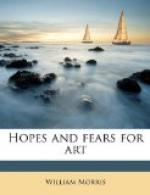When the brightness of the so-called Renaissance faded, and it faded very suddenly, a deadly chill fell upon the arts: that New-birth mostly meant looking back to past times, wherein the men of those days thought they saw a perfection of art, which to their minds was different in kind, and not in degree only, from the ruder suggestive art of their own fathers: this perfection they were ambitious to imitate, this alone seemed to be art to them, the rest was childishness: so wonderful was their energy, their success so great, that no doubt to commonplace minds among them, though surely not to the great masters, that perfection seemed to be gained: and, perfection being gained, what are you to do?—you can go no further, you must aim at standing still—which you cannot do.
Art by no means stood still in those latter days of the Renaissance, but took the downward road with terrible swiftness, and tumbled down at the bottom of the hill, where as if bewitched it lay long in great content, believing itself to be the art of Michael Angelo, while it was the art of men whom nobody remembers but those who want to sell their pictures.
Thus it fared with the more individual forms of art. As to the art of the people; in countries and places where the greater art had flourished most, it went step by step on the downward path with that: in more out-of-the-way places, England for instance, it still felt the influence of the life of its earlier and happy days, and in a way lived on a while; but its life was so feeble, and, so to say, illogical, that it could not resist any change in external circumstances, still less could it give birth to anything new; and before this century began, its last flicker had died out. Still, while it was living, in whatever dotage, it did imply something going on in those matters of daily use that we have been thinking of, and doubtless satisfied some cravings for beauty: and when it was dead, for a long time people did not know it, or what had taken its place, crept so to say into its dead body—that pretence of art, to wit, which is done with machines, though sometimes the machines are called men, and doubtless are so out of working hours: nevertheless long before it was quite dead it had fallen so low that the whole subject was usually treated with the utmost contempt by every one who had any pretence of being a sensible man, and in short the whole civilised world had forgotten that there had ever been an art made by the people for the people as A joy for the maker and the user.
But now it seems to me that the very suddenness of the change ought to comfort us, to make us look upon this break in the continuity of the golden chain as an accident only, that itself cannot last: for think how many thousand years it may be since that primeval man graved with a flint splinter on a bone the story of the mammoth he had seen, or told us of the slow uplifting of the heavily-horned heads of the reindeer that he stalked: think I say of the space of time from then till the dimming of the brightness of the Italian Renaissance! whereas from that time till popular art died unnoticed and despised among ourselves is just but two hundred years.




